Today is the Twelfth Day of Christmas and the feast of epiphany, the day the three wise men presented their gifts of gold, frankincense, and myrrh to the Holy Family. As a day of giving and celebration, it’s a good day for treats and desserts, such as muffins.
The Place of Baked Goods in the PHD
Our PHD Food Plate has a section for “Pleasure Foods.” It occupies the stem and leaves of our yinyang apple, indicating that these should be relatively small parts of the diet.
Baked goods are not mentioned, but it would be appropriate to list “Gluten-free baked goods and fructose-free sweets” among the Pleasure Foods.
These foods are made of PHD-compliant ingredients – rice flour, potato starch, and tapioca starch in the case of baked goods – but they have a few defects:
- Low nutrient density. As a purified macronutrient, gluten-free flour is unaccompanied by micronutrients.
- Low water content. Whole food starches, like white rice and white potatoes, typically have less than 500 calories per pound due to a high water content. But flours and foods made from them, like noodles and pizza dough and bread, lack water and provide 1300-1500 calories per pound.
The lack of water is potentially a problem because water is crucial to digestion, especially digestion of proteins. In the stomach, food needs to be dissolved in an acidic water bath in order for protein-digesting enzymes like pepsin to work properly. Dry foods are just not digested well.
Flour-based foods may be problematic for more reasons than their lack of water. Last year, Ian Spreadbury proposed that “acellular carbohydrates” – carbohydrates that are not surrounded by cell walls and embedded within a cytoplasm – may be unhealthy because the carbs can feed bacteria in the upper digestive tract which can then infect important organs like the pancreas, gallbladder, liver, and small intestine. Cellular carbohydrates would be digested lower in the intestine, helping to maintain an antiseptic and healthy upper small intestine.
We included gluten-free spaghetti and lasagna as items in the meal plan template of our book, but only on one day per week, and only in combination with sauces that provide water.
Due to their dryness, baked goods are probably best eaten as desserts – in combination with fat and liquids, but not much with protein, as they may interfere with protein digestion.
This means they are not good for a weight loss diet, but are excellent foods for those who naturally eat a low protein, high-carb-and-fat diet: children!
Baked goods are kiddie foods. Children eat a lot of calories per unit body weight, so they generally aren’t going to be malnourished; a certain amount of empty calories is just fine. And children’s diets should be lower in protein (7% protein at infancy, rising gradually to 15-20% protein in adulthood) and higher in carbohydrate (40% carb at infancy, decreasing to 20-30% carb in adulthood) than adult diets. That means less meat and more dessert type foods for the kids.
So here’s a recipe to please your children: muffins.
Gluten-Free Muffins
For some reason, gluten-free flours sold in stores are often far more expensive than their ingredients purchased individually. They also tend to have anti-caking agents and stabilizers that are unnecessary if you mix your own.
For muffins, we start by mixing our own gluten-free flour. For 3 cups of flour we use:
2 cups rice flour
2/3 cup potato starch
1/3 cup tapioca starch
We recommend combining dry and wet ingredients separately. In a mixing bowl, combine:
2.5 cups gluten-free flour
1.5 tsp salt
0.5 tsp baking soda
2 tsp baking powder
Cinnamon and nutmeg to taste (0.5 tsp each for us)
1 stick (4 oz / 113 g) butter cut into small pieces
With your hands, kneed this mixture until the butter has merged with the flour into a consistent texture; squeeze any buttery blobs until the butter is well mixed. At this point, mix in a cup of your choice of flavoring ingredient:
1 cup raisins or blueberries or chocolate or ground nuts
In a separate bowl, combine the wet ingredients:
1 1/3 cup milk
2 large eggs
1/3 cup honey
1 tsp vanilla
The final volume should be about 2 cups, add milk as necessary to achieve that.
After mixing the wet ingredients, combine them with the dry ingredients and mix well.
Pour the mix into a muffin sheet and bake at 350 F (175 C) for 20 to 22 minutes.
Eat the muffins with something fatty (butter, whipped cream, creamy cheese, or sour cream all work) and maybe a sweet topping (such as fruit, berries, jam, or honey). Note: the following photos don’t have enough butter!
Conclusion
Muffins are a great dessert or kid’s treat. Topped with 1-2 tablespoons of butter and accompanied by a drink to aid digestion, they taste great. They won’t help you lose weight, but they just may raise your spirits.







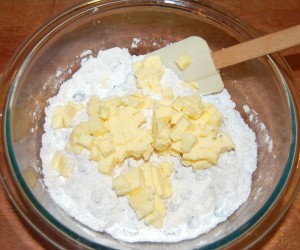
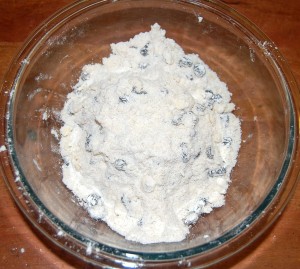
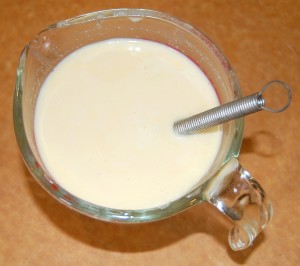
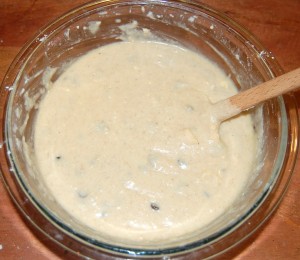
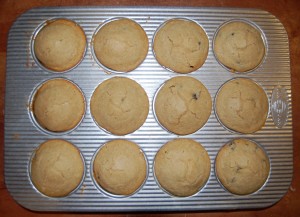
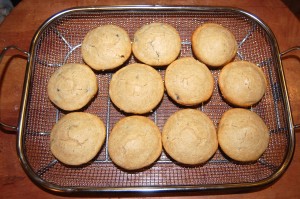
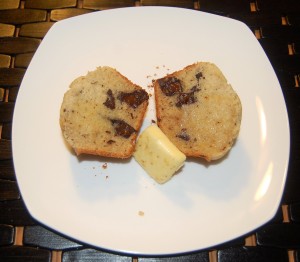
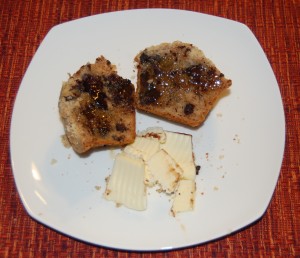
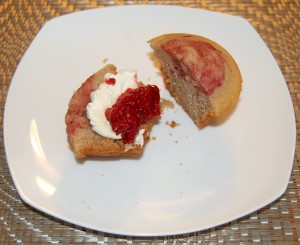




I am so glad to see this recipe and the accompanying reassurance about kids eating lots of carbs. My 4 year old loves bread and I have been trying to figure out some (somewhat) healthier alternatives. Thanks!
Hi Paul,
This isn’t about those yummy-looking muffins! but about your intro to the post… the feast of epiphany and the three wise men presenting their gifts. It reminded me of our favorite movie to watch around Christmas time (sometimes we watch it a few times a year because it’s just good, goodness, all that, makes us happy cry). It’s called The Nativity Story. We highly recommend it if you haven’t seen it, or even if you have!
I think we just decided we’re going to watch it tonight.
Bless you both!
KH
Paul – You could easily write a whole series of Perfect Health Diets, sort of in the fashion of the “______ for Idiots” series. PHD for kids, PHD for teens, PHD for college students, PHD for military, PHD for office workers, PHD for athletes, PHD for vegans, PHD for senior citizens….the categories are endless.
Oops, I meant “_______ for Dummies”…
All the four your using will really spike the blood!
Good point, this is not for diabetics.
So you’re saying rice has more water in it then rice noodles? Does it just absorb less when it boils? Seems like the same thing, just a different shape.
cooked Rice noodles looks to be an exception (unlike non-rice noodles),
according to cronometer.com & nutritiondata.com cooked rice noodles has a similar water content to cooked rice (glutinous & long grain) and cooked boiled potatoes (without skin).
Huh, strange. Thanks Darrin!
I sometimes make a gluten-free chocolate muffin (that is amazing, if I do say so myself) for the kids that uses blenderized black beans instead of flour. I soak and cook the beans really well, so I sort of categorize these muffins as “not ideal, but better than some things.” What do you think about using beans occasionally like this?
Please send me the recipe! Gooditalianfood@gmail.com
My kids loves black beans! 😮
I think if the beans are soaked overnight, they’re not too bad. I think it’s acceptable.
Mmmmm, baked goods. I really don’t need any more encouragement to bake! When I bake GF, I use rice and tapioca flours as you do, but I also use 1/3 – 1/4 of the total as almond flour. I really like what it does for the taste and texture. I know that nuts are a “moderation” part of the PHD, I’m curious about what you think of using the flour to bake with. If it gets the thumbs-up, you should try it, especially if Shou-Ching is thinking of putting some baked goods in her cookbook.
Hi Laura,
We’ll have to experiment with it. Thanks for the tip!
Speaking of baked goods, does anyone have an easy recipe for gluten free pizza crust or a good source to buy GF pizza shells. The ready made shells I have seen have been brown rice flour not white rice flour.
Hi SC,
We’ll put it on our agenda.
I conjured up this one and it’s been a huge hit among my non-PHD friends (and my kids etc.):
http://comercomojuan.wordpress.com/2011/05/25/pizza/
Here’s another one from the Domestic Man:
http://thedomesticman.com/2012/12/13/cast-iron-skillet-grain-and-gluten-free-pizza
I’ve made domestic man’s recipe twice now, it’s excellent.
My family has been using Mama’s GF Pizza Crust Mix, which contains white rice flour, potato starch, and tapioca starch. It may not be perfect, but pretty good by PHD standards, I think. Oh, and it tastes GREAT!
http://www.amazon.com/Gluten-Free-Mama-18-1-Ounce-Pouches/dp/B002YR7BEK
Hi Paul and Shou-Ching.
I just finished reading your book tonight ( fascinating, and have started to alter our diet from Paleo) and I am glad to see this post, as I have been wondering about baked goods. On the Paleo plan I did make some grain free indulgences for the kids (and my husband and me!), using both almond flour and coconut flour with high egg ratios and have liked both – I find the especially the high protein content tends to really satisfy and keep the energy level. I see that in the earlier comments, another reader also uses nut flour and I am glad to see that you are not opposed. I haven’t tried using rice flour and starch as I have been concerned that those ingredients could raise blood levels. I would love to hear more on your thoughts about nut flours. I have also wondered about the omega six aspect when making these for the family ( we don’t use any veg oils of course). Thanks!
Hi Jennifer,
On the starch raising blood glucose levels, you might look at this post: http://perfecthealthdiet.com/2011/10/how-to-minimize-hyperglycemic-toxicity/. Using lots of butter on the muffins helps prevent high blood glucose afterward.
Nut flours I think are OK in moderation.
Hey Paul,
When it comes to jam do you buy sugar free jam, or do you just use a normal jam with sugar in it as a treat every now and then?
Jude
Hi Jude,
We generally don’t buy jam, but we were given some organic jams as a gift for Christmas. We would prefer jams without added sugar or, if sugar was added, with added dextrose, not sucrose.
A great jam to try is chia seed jam.. it’s super tasty and PHD friendly. http://www.eatingbirdfood.com/2012/05/easy-strawberry-chia-seed-jam/
and you could even use rice syrup or tapioca syrup to sweeten it up a bit.
I’ve been substituting xylitol for sugar in jam recipes, and it works really well. I add coconut sugar if I want a more caramel flavour.
Hi Paul. I haven’t yet bought the book, but it’s in the plans. You say: And children’s diets should be lower in protein (7% protein at infancy, rising gradually to 15-20% protein in adulthood) and higher in carbohydrate (40% carb at infancy, decreasing to 20-30% carb in adulthood) than adult diets. That means less meat and more dessert type foods for the kids.
Is this covered in the book (with the reasoning behind these suggestions and references)? Thanks.
Hi Stipetic,
Yes. The infant ratios are the ratios of human breast milk – 7% protein, 39% carb. The adult ratios are the ones we reach from various arguments in the book.
Yes, but… how many of those carbs are for the infant and how many for her/his gut bacteria? This from the NYT last June:
“The baby’s microbiome continues to grow during breast-feeding. In a study of 16 lactating women published last year, Katherine M. Hunt of the University of Idaho and her colleagues reported that the women’s milk had up to 600 species of bacteria, as well as sugars called oligosaccharides that babies cannot digest. The sugars serve to nourish certain beneficial gut bacteria in the infants, the scientists said. The more the good bacteria thrive, the harder it is for harmful species to gain a foothold.”
http://www.nytimes.com/2012/06/19/science/studies-of-human-microbiome-yield-new-insights.html?pagewanted=all&_r=0
just curious…
I haven’t received the book I ordered yet, but have learned so much from your site and podcasts; thank you!
Nancy
Yes, I just finished reading that section of the book this morning! It’s so fascinating. I wasn’t sure how much I was going to learn because I’ve been reading Paleo blogs and books for years, but the PHD book is just incredible. I love all the science!
Hi, Paul –
So for those who just HAVE to have their baked goods (like my wife), can the lack of water in the flour be offset simply by drinking more while consuming the treats? If you properly hydrate during the meal with the baked goods, will that provide sufficient water for proper digestion?
Thanks!
Jim
Hi Jim,
Yes, I think having a drink along with the muffins will help.
So…it would have been good to say that in this article, instead of all the scaremongering “don’t eat dry baked items!!!”
Saliva and sipping any beverage neatly takes care of that “danger”. And dry baked items absolutely should have been included in the book and diagram.
The muffins I have been making for years now iinclude not only the rice flour, potato starch and tapioca, but ground almond meal, sometimes also a tiny bit of pumpkin and/or sunflower seed meal as well as quite a bit of finely shredded Coconut and little bit of coconut flour. I figured a liittle bit of everything would be better than a lot of one thing.
If I have some I use coconut kefir instead of coconut milk, and I use ghee or coconut oil since hubby does not do well with dairy. Frozen cranberries work well in these along with a bit of cinnamon.
I very rarely eat these, but they freeze well and are always a hit with “normal” people. So I like to have them on hand.
Those sound good! Do you have a recipe?
Melt. 1/4 cup coconut oil or ghee
Mix: 3/4 cup almond meal
1/2 cup pumpkin/ sunflower meal
2 T white rice flour
2 T tapioca flour
2 T potato starch
2 T sweet rice flour
1T coconut flour
3/4 cup shredded coconut
1/2 t salt
1/2 t baking soda
1/2 t cinnamon
Mix: Melted coconut oil or ghee
3 or 4 eggs depending on size
3 T coconut kefir or yogurt
1/4 cup maple syrup
Blend both mixes and add:
two handfuls of frozen cranberries Or blueberries
Fill silicone muffin cups
Place on tray and bake at. 375 for about 17 minutes depending on your oven. Test with toothpick.
You could probably have just as good results eliminating one or two of the Flours and doubling up on the others . I just had them all on hand when I made this up and have never tried another way…also I soak and dry my pumpkin seed and grind them so there are a variety of sizes. This give a nice texture. And I think the coconut kefir or yogurt makes them tender. I store them in the fridge or freezer and reheat befor serving.
Thanks, I’ll have to give them a try!
I should point out that the advantage of these is that while providing some safe starches the nuts, seeds and coconut make them a more moderate carb treat for those who need to be more careful
Excellent Gluten free Coffee cup muffin
Place ingredients in a coffee cup, stir with a fork and bake for one minute in the microwave.
Coffee cup muffin
1 egg
1 tablespoon finely ground almonds
1tablespoon unsweetened dessicated coconut
1 tablespoon of rice flour or flour of choice
1 packet of stevia or sugar or honey
1 teaspoon of coconut oil or olive oil or oil of choice
1 teaspoon of gluten free baking powder
Optional additions
1 tablespoon chia seeds
1 teaspoon of chocolate nibs
1 teaspoon raisins or craisins
1 teaspoon of chopped nuts
half a teaspoon of cinnamon
The tablespoon of rice flour could also be replaced with either extra coconut or almond flour.
or you could replace the tablespoon of almond flour, coconut and rice flour with any other flour/meal of choice
I make my own almond flour and butter
Flour
in 220 degree convection oven roast raw almonds for 20 minutes
Grind to flour in a blender – I make a batch and just keep it in the fridge.
Thanks for the excellent explanation and serving suggestions!
According to Tim Ferris(the 4 hour body)both Lemon Juice and Cinnamon taken with high glucose foods can stop blood sugar spikes quite considerably,I always sprinkle a little freshly ground cinnamon on my rice porridge and banana pudding having had 3 tablespoons of fresh lemon juice first.
Hope this may be of help.
Chris Hello from Elize
I ate paleo for quite some time but did notice that my Hashimoto condition became worse – my T3 levels dropped is low and I am always cold. Jus three days ago heard of this diet. I had two rice cakes at breakfast with two boiled eggs and a teaspoon of coconut oil. Soon thereafter I felt very tired and had to lie down. Could I drink the lemon juice and cinnamon in hot water before the meal? Would this help with the blood sugar spikes. I eat gluten free/paleo and now want to introduce more carbs but seem to react to it. I tried brown rice mixed with coconut oil and home made almond butter as well. How long will it take for me to feel better with the introduction of more carbs as my energy levels and temperature is always low.
Hi Elize,
It is good that you’re introducing carbs. Fatigue afterward indicates some combination of leaky gut and gut dysbiosis — it means that either food particles or bacterial cell wall components are entering the body and causing an immune reaction. It is probably gut microbes reacting to the carbs — you may have SIBO or something like that. That is not uncommon after being too low carb.
So you have to reintroduce carbs gradually and make sure you are well nourished to support immune function. Liver, bone and joint broth soups, shellfish and seafood are good micronutrient sources. For carbs, try whole food sources like white potatoes and home-cooked white rice, these are more easily digested than anything made with flour.
Vinegar works better than lemon juice in controlling blood glucose. see our post “How to Minimize Hyperglycemic Toxicity”.
Best, Paul
Thanks a lot for your comment Paul.
I just wonder about something else. I use Hydrochloric acid tablets before each meal. Would this be good or bad when introducing safe carbs. Since using these would I still need to do the vinegar/cinnamon with carbs. I do eat fermented foods, kimchi, coconut kefir etc as well.
Blessings and thanks
That would be fine. Be sure you get enough water with meals. The acid needs to be dissolved in water, and flour-based foods like muffins are not good and might lead to reflux. Whole foods like potatoes and cooked white rice would be better, they carry their own water.
Thanks a lot Paul.
Going to buy your book today and look forward to spend time reading it.
Elize
Thanks for this excellent information. Very helpful, especially for anyone contemplating buying the truly horrible gluten-free baked goods out there (run away, just run!) A few years ago, I tried some baking, and used brown rice flour. Didn’t like it one bit. Very heavy product. I can’t believe anyone would eat the brown rice flour tortillas from Trader Joe’s, but some people do.
Paul, it seems that in PHD v.2, you have elevated buckwheat to *nearly* the level of a safe starch. Buckwheat is quite useful in baking (http://www.amazon.com/Delicious-Gluten-free-Baking-Buckwheat-Flour/dp/0615280412/ref=sr_1_1?s=books&ie=UTF8&qid=1357613481&sr=1-1&keywords=buckwheat) but as I look around the paleo blogosphere, I see that there is a concern with phytic acid. Buckwheat seems to have high levels of both phytase and phytic acid, making it a good candidate for sourdough fermentation. But if fermentation is necessary, that makes me wonder why you gave it a B rating and not lower? Perhaps WHOLE-GRAIN buckwheat is high in phytic acid while white buckwheat flour is not? Is your B rating for buckwheat for whole grain flour or white flour…or simply for groats and not the flour at all? What are your thoughts on using buckwheat flours? Thanks!
Hi Christopher,
I guess we were feeling generous that day. Since it’s not actually a grain, but rather a rhubarb relative, we weren’t quite as prejudiced against it as we would be if it were a true grain; and it seems to have a reasonably good track record as a grain alternative. There is limited toxicity information so no guarantees. Phytic acid isn’t much of a concern, it comes bound to minerals in natural foods and can even be beneficial in some circumstances. I agree fermented buckwheat would be better, also soaked and sprouted.
Hi Paul,
Your response above has me re-thinking how I understand phytic acid. I realize that on a practical level, as long as we eat an otherwise nutrient-dense/replete diet and phytic acid containing foods are kept to occasional pleasure foods (nuts and buckwheat chocolate cake), then it’s not an issue.
But how does phytic acid work? I previously understood (and I think it is very commonly understood this way) that phytic acid in foods is bound to phosphorus and when eaten, it then binds to minerals in your digestive tract. The phytic acid not only holds the phosphorus that it comes attached to but also sequesters the minerals released from other foods eaten with it. This view is summarized nicely here (first paragraph): http://sherryfredley.com/2012/08/19/phytic-acids-what-you-need-to-know/
Your previous reply seems to say something different: that naturally occurring (bound) phytic acid will not give up it’s phosphorus but it WON’T sequester additional minerals and, I think, you imply that free phytic acid (if there is such a thing) WILL sequester other nutrients. I think I read once that free phytic acid is used to chelate uranium.
Secondly, (off topic) what are your thoughts on the A1 vs. A2 casein issue? WAPF/Dr. Cowan gave “Devil in the Milk” a thumbs-up review, not surprisingly as Dr. Cowan wrote the foreword to the book. Safe starch…safe dairy?
Thanks so much and may you and Shou-Ching have a blessed Lent!
Hi Christopher,
You have understood my view correctly.
A discussion of A1 vs A2 casein which covers most of the bases can be found here: http://www.facebook.com/jaemi/posts/428703767203312. It’s not likely to be a concern except in people whose digestion is not working properly.
Paul,
Thanks for the link to Montiel’s article summarizing A1 & A2 casein issues.
Sorry to beat a dead horse, but I am intrigued by your position on phytic acid and I’m hoping that you will elaborate it further. For example, the wikipedia article on phytic acid says, “Moreover, it [phytic acid] chelates and thus makes unabsorbable certain important minor minerals such as zinc and iron, and to a lesser extent, also macro minerals such as calcium and magnesium.” Why is this wrong? What am I missing to not understand why your position seems to be different than this commonly accepted one?
Hi Christopher,
Phytate in plants generally comes pre-bound to minerals so it can’t chelate additional minerals and thus doesn’t cause mineral deficiencies.
Many people have iron overload and phytate has a preference for iron, so it might actually do some people some good.
In fact, free phytate is sold as a supplement and touted as a cancer treatment. See eg http://www.naturalnews.com/024635_IP6_cancer_research.html.
I’m not persuaded that it’s beneficial but I don’t see it as a demon that we need to go out of our way to remove from our food.
These look really good! Is there any reason you couldn’t just soften/melt the butter and mix it in with the wet ingredients?
I really like the idea of using white rice flour and starches to bake. I rarely make Paleo baked goods because baking the omega-6 fats in nuts makes me uncomfortable, and I can’t eat coconut flour because it’s too much fiber. Sometimes I’ll soak almonds, dehydrate them, grind them myself, and use the nut butter to make muffins, but that’s very occasional!
I wasn’t expecting to learn something new from a muffin recipe, but I seem to learn something new every single time I visit! I had no idea the water content of baked goods was an issue! That is very good to know, because I always make it a point to NEVER drink with my meals. I read somewhere that drinking with meals dilutes your HCl, making digestion harder. Is this true in cases where foods have normal water content?
Hi Alyssa,
The recipe did have butter, we included it in the dry ingredients. We do encourage buttery muffins. The advantage of mixing it in the dry ingredients is that it doesn’t separate and you don’t have to heat/melt it which might pre-cook the eggs when you mix melted butter in the wet ingredients. But, there’s more than one way to skin a cat.
Whole foods with normal water content should digest well without drinking any water. I think with baked goods or foods that were dried out in cooking, like baked potatoes, some fluid along with dinner is not amiss.
We usually have a bowl of soup and a glass of wine with dinner, but neither is obligatory.
Paul, Everything you say in both books makes a lot of sense and that is what draws me to your work. I know you lean towards agreeing with most of what Weston Price/Sally Fallon have said in their books and you were even a guest at one of the WP conferences. I have read a LOT your blog posts as well as own both books now, but never really saw what your stance was with wheat if if is sprouted as suggested in Nourishing Traditions or if we use Einkorn wheat, which is a bit pricy but I noticed when I bake with it or buy Einkorn pasta I don’t get that tired feeling afterwards as I use to with modern wheat. I’d love to hear your thoughts…
Hi Mike,
Those forms of wheat are less bad but they still have some wheat toxins. I feel that as we recommend only 30% carbs and a fair number of safe starches which are available as gluten-free products of various kinds, it’s not necessary to eat the wheat products. But our general philosophy, we provide the reasons and evidence behind our recommendations so that you can form your own risk/reward judgments.
I think even steamed potatoes can be dehydrating. If I go to bed too soon after 40 grams carb from potatoes and 4 oz beef (less than 3 hours), I’ll wake up in the middle of the night dehydrated. And I’ll pay for it later with constipation. Experimenting…
Thanks for the recipe Paul!
I like these muffins from Bruce Fife’s book “Cooking with coconut flour”
Sometimes, I add blueberries, cranberries, nuts etc.
COCONUT MUFFINS
3 eggs
2 tablespoons butter, melted
1/3 cup sugar
¼ teaspoon salt
½ teaspoon coconut extract
¼ cup sifted coconut flour
¼ teaspoon baking powder
3 tablespoons grated coconut
Blend together eggs, butter, sugar, salt, and coconut extract. Combine coconut flour with baking powder and whisk into batter until there are no lumps. Fill muffin cups halfway with batter. Sprinkle grated coconut on top. Bake at 400 degrees F (205 C) for 15 minutes. Makes 6 muffins.
Paul, I made your muffins this morning and they were a pleasant surprise! We’re reformed muffin/bagel/cinnamon roll eaters and these really hit the spot. I’m excited to try this GF flour out on some old favorites like scones, shortbread and quiche crust. Last year, I was sprouting and grinding my own wheat flour…this year I’ve decided to go without wheat completely. Thanks for posting this!
I made these today using mini chocolate chips and baking them in a mini muffin pan (they needed 12 minutes in the oven). My 2-year-old approves! Thanks! 😛
Hi Paul,
Those muffins look great! I’m curious about the choice of honey as a sweetener, though… doesn’t honey have a lot more fructose in it than comparably sweetening amounts of stevia, dextrose, or even cane or maple sugar? Is there something about honey that makes its fructose less unhealthful, or about raw cane or maple sugar that makes them worse than honey?
Hi Luke,
Well, it’s hard to find the perfect sweetener. The easily obtainable rice syrups are brown rice syrup which will have the brown rice toxins and can concentrate arsenic, so we’re less thrilled with that. We’ve given up on calorie-free sweeteners for the most part. I think as long as you don’t use much honey, it’s fine.
We recommend about an 85% glucose / 15% fructose or 90% glucose / 10% fructose mix so that the “catalytic” function of fructose in the liver aids glycemic regulation. Since the muffin flour is 100% glucose and the honey is 50% glucose, these muffins with honey are probably 90% glucose and 10% fructose. I think it’s OK.
I like honey better than cane sugar and maple sugar because it has antimicrobial compounds that are good for the gut.
Re the honey having anti microbials:
Are they still active in cooked honey?
Are the benefits of raw honey separate for the ones you refer to here?
Make that:
Are the benefits of raw honey different from the ones you refer to here?
Hi Ellen,
I was thinking of raw honey. Good question about cooked honey, I would imagine that gentle cooking preserves them but don’t know. Good topic for investigation.
Paul, is stevia ok?
It’s OK.
Hi Paul,
I did a search to make sure I wasn’t brining up something you had already touched upon. I was curious as to what you thought about Robb Wolf’s recent blog posts? His sudden turn around and acceptance of safe starches including potato and white rice recommendations are very similar to yours. I have to admit I admire the guy for admitting his previous views were no longer correct based on good science and practical application. I think it’s a step in the right direction in hopes of improving the way we eat here in America. Paleo is not low carb, nor is it keto adpatation. There are too many that treat LC as a religion.
Hi Mike,
I think it’s great. Soon we’ll agree on everything.
I made these using I c rice flour, 1c almond flour and 1/2 c tapioca starch.
I put 1/2 c raspberries and 1/2 c chocolate chips.
My 3 kids and husband couldn’t keep their hands of of them!
Thank you so much for the recipe and the book! I am half way through it and already making changes in our eating and feeling great!!
I have been experimenting with this recipe and found I got a moister, light muffin using some sweet rice flour (about 1/4 cup) and 1 Tbs. potato flour in place of some of the white rice flour. I did this because my first attempt at your recipe was okay but Not optimal…. Rather dry. Of course in that attempt I was subbing ghee for butter, coconut milk for milk and I forgot the sweetener, so actually it was rather surprising that they were any good at all
In my recent experiment adding on the sweet rice flour and potato flour I did use real butter, remembered to add the sweetener ( I used maple syrup) but still used coconut milk in place of the stuff from a cow.
So my question is: in coming up with this recipe did you try any proportions that included sweet rice flour and some potato flour and just not care for the result or did you not try them at all?
I know you like coconut oil and coconut milk, but what is your opinion of coconut flour in baked products? Do you prefer rice flour over coconut flour?
Hi Peg,
Coconut flour is fine to use, but it is a very different food — not many carbs, lots of fiber.
Hi Paul – recently bought the book and have been taking steps over the past couple weeks towards all the PHD guidelines, including the supplements. This post about muffins for kids and their lower protein / higher carb needs brings to mind a question. We have two kids (6 & 2) – do you recommend supplementing any vitamins/micro-nutrients for children?
Hi Rob,
Supplements are less important for children because they eat more food relative to body weight, so food is more likely to be sufficient. Vitamin D is the most likely supplement they will need. If they eat a healthy whole foods nutrient-rich diet, I wouldn’t supplement, but if they are picky/restricted eaters then I would think about what they might be missing and consider supplementation.
Thanks so much for your reply! I purchased some D/K2 drops for them, especially for during the winter months since we live in Illinois. Our kids can be somewhat picky, but generally eat what we eat. The tricky thing with supplements for kids is having to find drops or chewables.
Really enjoyed the book and searching through the blog.
These muffins are delicious! Thank you for sharing! They are perfect for substituting at my daughters daycare since they are nut free.
Thank you Paul, this Muffin recipe looks great!
Besides look delicious are not complicated to prepare, this weekend I’ll make some, so I hope I stay well.
Just wanted to say again how much I love these! I use them as biscuits instead of muffins. I don’t use vanilla or cinnamon. I freeze them raw, after everything has been mixed together then when I want to cook one I put it in a cold oven, turn to 400 and time for twenty minutes. Perfect for bacon sandwiches!
Hello,
Do you know of any substitute for baking soda/baking powder? A little known fact is that baking soda is toxic to the body partially because it is simply way too alkaline. In most people their body can deal with it before it causes any noticeable side effects, but in my case it cannot.
A couple months ago I tried a drink made of 1/2 a teaspoon baking soda and the juice of half a lemon. The first two times I drank this I didn’t have any bad effects, but on the third time I developed a lot of the symptoms of alkalosis and baking soda poisoning including serious muscle weakness, abdominal convulsions, frequent urination, feeling extremely cold (even 4 blankets couldn’t keep me warm), really nasty canker sores to the extent that I literally couldn’t eat because I couldn’t chew w/o biting them and they were extremely painful, and the worst part – a constant disgusting aftertaste of baking soda that permeated throughout my whole body and lasted for at least 2 days afterwards. I thought that the citric acid in the lemon would neutralize the alkalinity of the baking soda, but that is NOT the case at all. It is still way super duper alkaline somehow in its reaction in the body even though the PH of the drink itself is exactly 7.0 neutral. While my body was getting rid of it my urine PH skyrocketed to over 8.
Ever since then if I consume any baking soda in food or any other way I start getting the symptoms again beginning with abdominal convulsions and for some reason that I cannot figure out I always get really bad canker sores the next day without fail. Some people actually recommend baking soda to cure canker sores yet it has the opposite affect on me lol… I haven’t had it in a while b/c I’m too scared and avoid it like the plague – it’s horrible stuff for me. May as well be putting poison in my food.
I do suffer from leaky gut, perhaps the increased intestinal permeability contributes to my vulnerability and baking soda isn’t a problem for people who don’t have leaky gut. I don’t know. But it’s something to look out for.
Regardless I would like some viable substitute to help things rise when I bake without using baking soda or baking powder. I’m not sure if anything exists?
Thanks!
Hi NinjaNight,
Citric acid is alkalinizing in the body (through its metabolism in the TCA cycle as citrate). You might do better neutralizing it with an acidifying acid like vinegar or vitamin C.
It shouldn’t be necessary to eliminate baking soda from recipes, just balance it in the diet. You may also be short of protein, salt, or calcium/magnesium which would help normalize pH.
NinjaNight, I also have a bad reaction to baking soda.
I am actually glad to read here that someone else is sensitive to it, because I haven’t come across anyone else who reacts badly to it, and people whom I mention it to think I am a bit nuts.
Even when it’s a small amount, such as 1/2 a teaspoon spread amongst 12 muffins or 24 cookies or something, and I eat only 1 of them, I still get noticeable stomach upset and acid reflux into my throat and back of mouth from the soda. Particularly when the recipe has nuts in it – I don’t know why.
I do sometimes get unexplained mouth ulcers, and I haven’t connected them to baking soda ingestion, but it’s possible and I will look out for that reaction in the future.
I also sometimes get really chilled-to-the-bone cold — I have a pituitary tumor, hypothyroidism, carpal tunnel in both wrists, and Raynaud’s, and my usual body temp is always lower than “normal” peoples’, so when something does bring my temp down a touch, I can take a long time to warm up, even under many blankets and such, like you described. I have not connected that deep-chilled reaction in myself to ingesting baking soda, and in my case, I don’t think they are connected, for me.
As for replacements, I have experimented with recipes where I would substitute the called-for baking soda with baking powder (I know they aren’t the same chemically, and they don’t create quite the same outcomes in most recipes),
or I just leave all leavenings out,
and the non-soda versions of the recipes are always much better for me acid-reflux-wise and stomach-wise.
I don’t bake much, and when I do, I just pop in a bit of baking powder in place of any baking soda that is called for (or, if the recipe just doesn’t work without the soda, I don’t make it, and I choose a different recipe),
but I have read that one can fold in separately-whipped egg whites to create some volume in baked goods, and this is one thing people would use for non-yeast-derived volume in the “olden days” before baking soda was mass-produced. I have not tried it myself because I am not an egg white fan.
(This site doesn’t go in much for egg whites, and probably not for baking powder either!
…I forget why baking powder is not “paleo” – I guess there is a bit of corn flour in it.)
There are other possible leavenings (theoretically) – a few years ago when I started to react badly to baker’s yeast, and I was still eating wheat flour and trying to find a simple recipe for sandwich bread that I could make, I read a little bit of the history of chemical leavenings, and learned that people used several substances before baking soda was mass-produced, but I don’t know if they are sold these days.
(Also, cream of tartar is easy to find in stores and it does something regarding leavening – at the moment, I am blanking on quite what it does… obviously, it’s nearly always accompanied in recipes by baking soda, so maybe it needs the soda to have any effect.)
Hello Paul
What are your thoughts on these ingredients for Ener-G brand hot dog buns?I’m looking for the best cheat I can.The hot dogs will be grassfed.Here’s the list: Ingredients: Filtered Water, Rice Flour, Tapioca Starch, High Oleic Safflower Oil, Pear Juice Concentrate, Bamboo Fiber, Yeast, Methylcellulose, Tapioca Syrup, Guar Gum, Organic Palm Fruit Oil, Salt, Orange Citrus Fiber, Calcium Phosphate ,Baking Powder (Glucono Delta Lactone, Calcium Carbonate & Magensium Carbonate). Enriched with Thiamin (Vitamin B1), Riboflavin Vitamin B2), Niacin, Iron, Folic Acid and Vitamin D.
View Nutrition Facts
I love making muffins which I now usually make with almond meal, but I want to try your muffins.
My daughter is lactose sensitive, can I use coconut oil instead of butter?
by the way I enjoy your nutrition program, and added potatoes and rice to my meals, great. thanks
I’m not American, so I need some help with the receipt. How much is a cup in decilitres? Is it always the same amout? If I remember correctly, then gallon and maybe something more also can differ, which makes it harder to google for the answer.
A cup is 2.4 deciliters.
Thank you!
Hello,
I’m wondering if whole food starch sources (say raw green plantains) that have been blended would be considered ‘acellular’ carbohydrates.
Thanks
Hi, Paul.
I recently listened to your podcast on liveto110 and heard you mention the fragile nature of starches in the food prep industry. Can you explain what is meant by this and also the possible effects on our health when using these certain flours? Specifically, we use white rice flour, tapioca starch, potato starch, and arrowroot flour. We are off all grains except rice. Our family, including the 3 children ages 6-16 enjoy making our own versions of grain free breads, pizza crusts, pancakes, and muffins, along with special desserts. How often should we do this? Adults included? Currently, we make Saturday night pizzas, pancakes on one morning, and buns for another meal. This would be weekly. Is this too frequently? We do have protein with this as we put cheese and meat on the pizza, and beef patties or sloppy joes on the buns. There is a weight issue that needs addressing for my spouse. Thanks for any advice you might offer. God bless you in all you are doing to redirect us on a healthier path.
Lisa
i have a question. is teff considered a cereal grain?i want to use teff flour in my diet but i’m not sure if its toxic or not.
hi paul, is teff toxic? i want to use teff flour in my baking.
can I use cornstarch if I make sure it’s not cross contaminated?